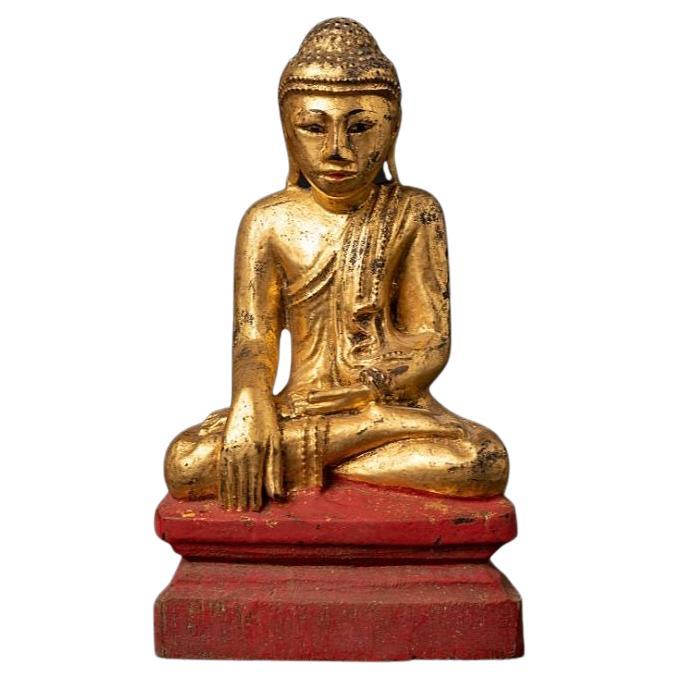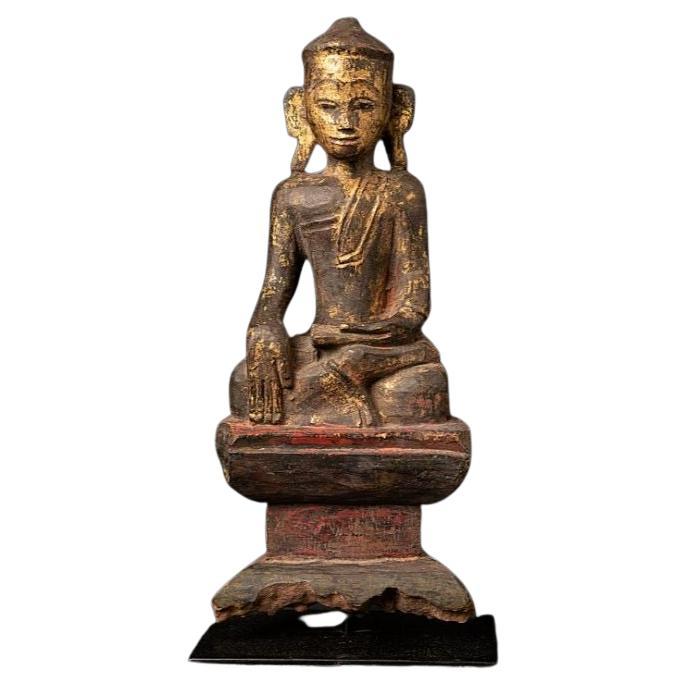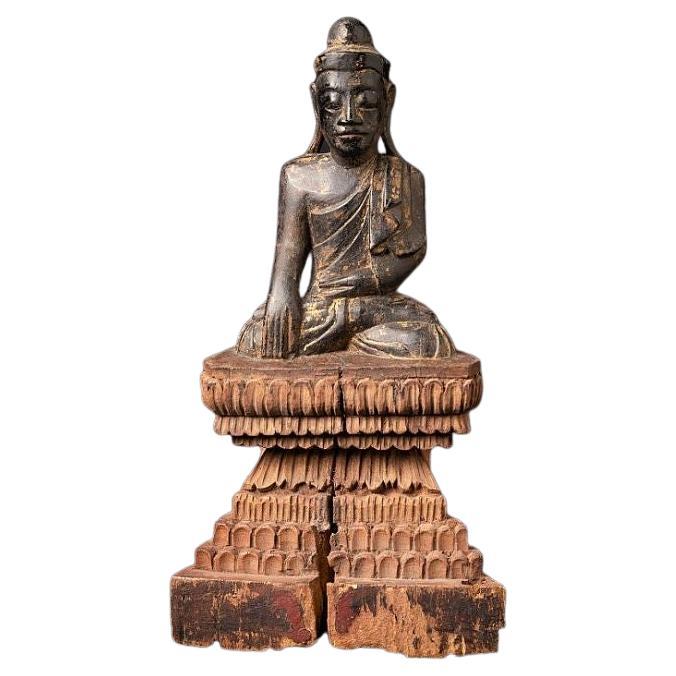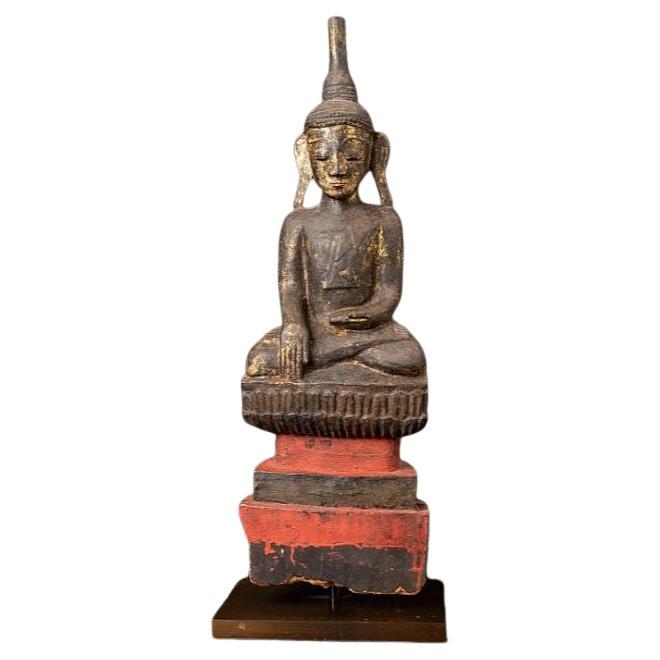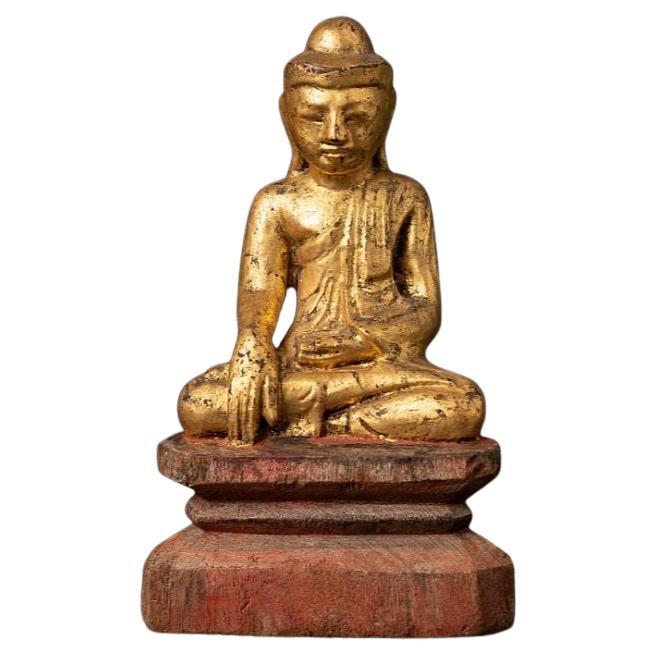Want more images or videos?
Request additional images or videos from the seller
1 of 21
Antique Wooden Burmese Buddha from Burma
About the Item
Material: wood
61,3 cm high
39,3 cm wide and 23,4 cm deep
Weight: 11 kgs
With traces of 24 krt. gilding
Mandalay style
Bhumisparsha mudra
Originating from Burma
Early 19th century
Very beautiful piece !
- Dimensions:Height: 24.14 in (61.3 cm)Width: 15.48 in (39.3 cm)Depth: 9.22 in (23.4 cm)
- Sold As:Set of 2
- Materials and Techniques:
- Place of Origin:
- Period:
- Date of Manufacture:Early 19th Century
- Condition:Wear consistent with age and use.
- Seller Location:DEVENTER, NL
- Reference Number:
About the Seller
5.0
Gold Seller
These expertly vetted sellers are highly rated and consistently exceed customer expectations.
Established in 1997
1stDibs seller since 2022
Typical response time: 9 hours
- ShippingRetrieving quote...Ships From: DEVENTER, Netherlands
- Return PolicyA return for this item may be initiated within 14 days of delivery.
More From This SellerView All
- Antique Wooden Burmese Buddha from BurmaLocated in DEVENTER, NLMaterial: wood 66,2 cm high 21 cm wide and 15 cm deep Weight: 2.184 kgs Gilded with 24 krt. gold Shan (Tai Yai) style Bhumisparsha mudra Originating from Burma 18th centuryCategory
Antique 18th Century Burmese Sculptures and Carvings
MaterialsWood
- Antique Wooden Burmese Buddha from BurmaLocated in DEVENTER, NLMaterial: wood 27,9 cm high 13,1 cm wide and 9,1 cm deep Weight: 0.794 kgs Gilded with 24 krt. gold Shan (Tai Yai) style Bhumisparsha mudra Originating from Burma 18th centu...Category
Antique 18th Century Burmese Sculptures and Carvings
MaterialsWood
- Antique Wooden Burmese Buddha from BurmaLocated in DEVENTER, NLMaterial: wood 39,2 cm high 20,6 cm wide and 9,6 cm deep Weight: 1.027 kgs Gilded with 24 krt. gold Shan (Tai Yai) style Bhumisparsha mudra Originating from Burma 18th centu...Category
Antique 18th Century Burmese Sculptures and Carvings
MaterialsWood
- Antique Wooden Burmese Buddha from BurmaLocated in DEVENTER, NLMaterial: wood 45,9 cm high 16,8 cm wide and 11,6 cm deep Weight: 1.262 kgs Gilded with 24 krt. gold Shan (Tai Yai) style Bhumisparsha mudra Originating from Burma 18th cent...Category
Antique 18th Century Burmese Sculptures and Carvings
MaterialsWood
- Antique Wooden Burmese Buddha from BurmaLocated in DEVENTER, NLMaterial: wood 24,3 cm high 14 cm wide and 9 cm deep Weight: 0.417 kgs Gilded with 24 krt. gold Mandalay style Bhumisparsha mudra Originating from Burma 19th centuryCategory
Antique 19th Century Burmese Sculptures and Carvings
MaterialsWood
- Antique Wooden Burmese Buddha from BurmaLocated in DEVENTER, NLMaterial: wood 22,3 cm high 13,6 cm wide and 8,6 cm deep Weight: 0.388 kgs Gilded with 24 krt. gold Mandalay style Bhumisparsha mudra Originating from Burma 19th centuryCategory
Antique 19th Century Burmese Sculptures and Carvings
MaterialsWood
You May Also Like
- Edo Period in Japan Wooden Buddha Statue / Wood Carving Buddha / 1750-1850Located in Sammu-shi, ChibaWe Japanese introduce unique items with unique aesthetics, purchasing routes and methods that no one can imitate. This is a small wooden Buddha statue made in the Edo period in Japan. And this pose is called "Shaka Nyorai". It is the highest Buddhist statue in Buddhism. It is a very precious existence that saves the lives of many people. I think it was in a private house such as a small village. Since it is a simple sculpture, it was not carved by a person who specializes in carving Buddha...Category
Antique Late 18th Century Japanese Edo Sculptures and Carvings
MaterialsWood
- Large Burmese Bronze Medicine Buddha, Pagan Style, Late 19th CenturyLocated in Austin, TXA large and magnificent cast bronze image of the Medicine Buddha, Bhaisajyaguru, rendered in the Burmese Pagan style, and most likely based on a period example that was either damaged or lost, 19th century, Burma or Thailand. He can be identified as the Medicine Buddha by the hand that rests in his lap, with his middle finger touching the thumb. A medicine pot or fruit stem would originally have been placed in his upturned palm. The face of this Buddha has been sculpted masterfully. He has a beautiful heart shaped face topped by hair neatly arranged in the typical "snail shell curls", and surmounted by a high ushnisha. Long, pendulous earlobes frame his face, a symbol of his princely past. He gazes serenely outwards from heavily lidded, downcast eyes, a content smile upon his full, lush lips. The Buddha is portrayed seated in vajrasana (full lotus position), his elegant hands displayed in varada mudra, the gesture of granting favors and fulfilling wishes. Long, exquisite fingers extended, the thumb and middle finger touching in a gesture of compassion. He is clothed in a simple kasaya wrapped around his body and over one shoulder, leaving the shoulder and part of his chest bare. The diaphanous garment clings to his body, outlining his well proportioned and graceful, almost sensuous, form. The excess material pooled in neat pleats in front of him. A sash thrown over his shoulder. He sits upon a double lotus base upon a raised platform. The platform features two kneeling attendants, usually interpreted as the monks Ananda and Kasyapa. Between them is a circular disc representing the Wheel of Dharma. Contained in the disk is a flower with eight petals, symbolizing the eightfold path, one of the principle teachings of the Buddha. The sides and back of the platform featuring a series of singha, or lions, representative of the Buddha's royal past. An applied lacquer patina covers the entirety of the image. Large deposits of ash (from incense) are present between the curls of the hair, as well as some the other crevices, indicating this image was the subject of worship for many years. Bhaisajyaguru, also called the Medicine Buddha, or Buddha of Healing, is a revered figure in the Buddhist pantheon as a master able to cure suffering, both physical and spiritual, through his teachings. The Pagan Empire ruled most of present day Burma (Myanmar) from 849 to 1297. The capital, Bagan, served as a both the center of government and religion, where Buddhism reigned supreme. Bagan was also at a crossroads of the Buddhist world, with influence from India, Nepal, Tibet, China, and even Indonesia shaping their culture. As such, Pagan Buddha...Category
Antique Late 19th Century Burmese Sculptures and Carvings
MaterialsBronze
- Burmese Mandalay Style Gilt Lacquered Buddha & Red Lacquer Covered Baluster VaseLocated in Ottawa, OntarioA Burmese Mandalay style gilt lacquered wood standing figure of Buddha and together with an unusual Burmese red lacquer covered baluster offering vas...Category
20th Century Burmese Chinese Export Sculptures and Carvings
MaterialsWood, Lacquer
- Large Early 19th Century Gilded Carved Wooden Vietnamese BuddhaLocated in Atlanta, GAA highly decorative early 19th century Vietnamese carved wooden and polychrome painted Buddha with traces of original gilding, creating a beautiful p...Category
Antique Early 19th Century Vietnamese Sculptures and Carvings
MaterialsWood
- Wooden Sword of Old Japanese Buddha / 1800-1900 / Wall-Mounted ObjectLocated in Sammu-shi, ChibaThis is an introduction to a slightly unusual item. This is a wooden sword possessed by the Buddha statue. Only the sword remained. Gods such as Fudo Myo, who reign as Buddhist guardians...Category
Antique 19th Century Japanese Edo Sculptures and Carvings
MaterialsCedar
- Old Japanese God "Ho-te-i", Wooden Sculpture, Buddha statue, 1912-1950Located in Sammu-shi, ChibaThis is Ho-te-i, an old Japanese god. hotei is one of the seven gods of good fortune in Japan. This god is plump and has a large pouch. He also carri...Category
Early 20th Century Japanese Taisho Sculptures and Carvings
MaterialsOther
Recently Viewed
View AllMore Ways To Browse
Early 19th Wooden
Burma Carving
Myanmar Buddha
Burma Buddha
Buddha Burma
Burmese Buddha
Asian Burmese Style
Asian Art Buddha Burma
Wooden Buddha
Burmese Wood Sculpture
Burmese Wooden
Burmese Wood Carving
Antique Burma Buddha
Antique Burmese Buddha
Antique Wood Buddha
Antique Wooden Buddha
Burmese Wood Buddha
Buddha Sculpture Wood Antique

